Content Menu
● Understanding the Importance of Proper Swimsuit Sizing
● Essential Measurements for Swimsuit Sizing
>> How to Measure Your Bust
>> Measuring Your Waist
>> Measuring Your Hips
>> Measuring Torso Length
● Tips for Accurate Measurements
● Understanding Swimsuit Size Charts
● Choosing the Right Swimsuit Style for Your Body Type
● Special Considerations for Different Swimsuit Types
● Online Shopping Tips for Swimwear
● Caring for Your Swimsuit to Maintain Fit
● Conclusion
Summer is just around the corner, and with it comes the excitement of beach trips, pool parties, and lounging by the water. As you prepare for these sun-soaked adventures, one essential item on your shopping list is undoubtedly a well-fitting swimsuit. However, finding the perfect swimsuit can be a daunting task, especially when it comes to getting the right size. Fear not! This comprehensive guide will walk you through the process of measuring your swimsuit size, ensuring that you'll look and feel your best when you hit the water.
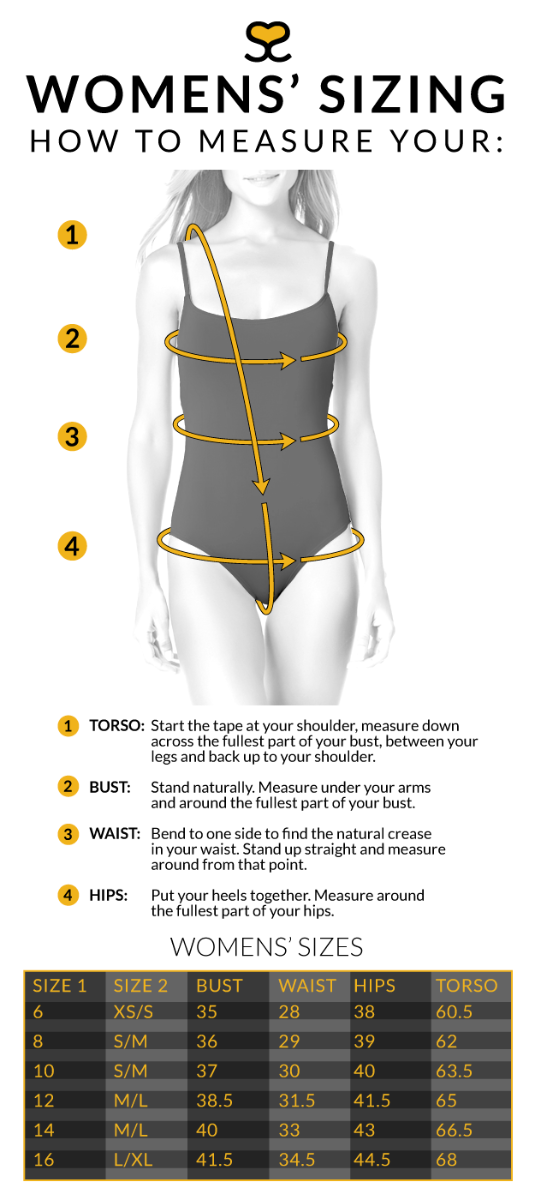
Understanding the Importance of Proper Swimsuit Sizing
Before we dive into the specifics of measuring, it's crucial to understand why proper swimsuit sizing is so important. A well-fitting swimsuit not only enhances your appearance but also provides comfort and confidence. Ill-fitting swimwear can lead to discomfort, constant adjustments, and even wardrobe malfunctions – situations we'd all like to avoid while enjoying our time by the water.
Moreover, different swimsuit styles and brands may fit differently, so knowing your exact measurements is key to finding the perfect suit across various retailers and designs. Whether you're shopping online or in-store, having accurate measurements will save you time, money, and the frustration of returns.
Essential Measurements for Swimsuit Sizing
To determine your ideal swimsuit size, you'll need to take several key measurements. These typically include:
1. Bust
2. Waist
3. Hips
4. Torso length (for one-piece suits)
Let's break down each of these measurements and learn how to take them accurately.
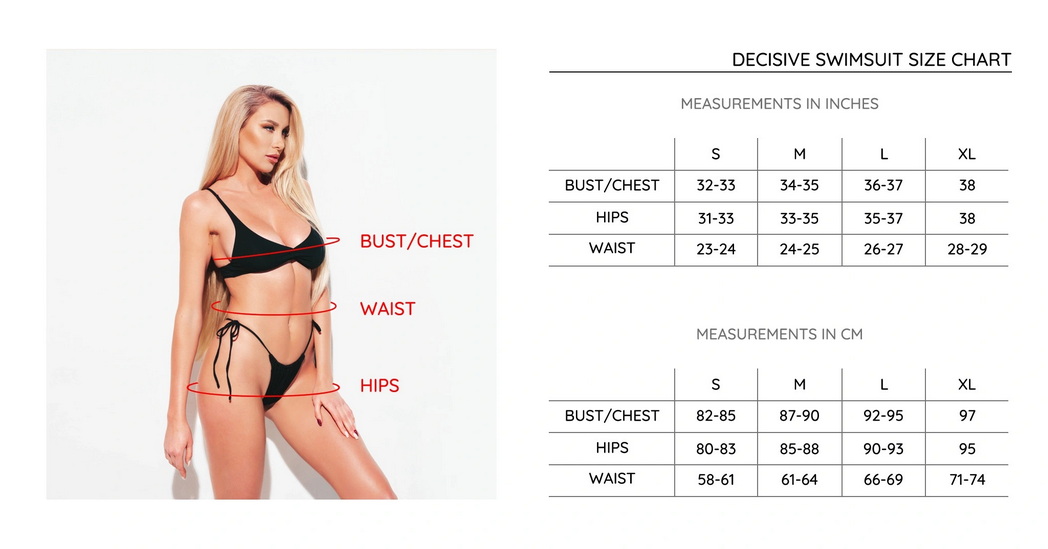
How to Measure Your Bust
Your bust measurement is crucial for ensuring a proper fit in the top portion of your swimsuit. Here's how to measure it:
1. Stand up straight with your arms relaxed at your sides.
2. Wear an unpadded bra or no bra at all for the most accurate measurement.
3. Wrap a soft measuring tape around the fullest part of your bust.
4. Make sure the tape is parallel to the ground and snug against your body, but not too tight.
5. Take note of the measurement in both inches and centimeters.
For those with a larger bust, it's also helpful to measure your underbust. This measurement is taken just below your bust where a bra band would sit. It can be particularly useful when shopping for swimsuits with built-in support or underwire.
Measuring Your Waist
Your waist measurement is essential for finding swimsuits that fit well around your midsection. Follow these steps:
1. Stand up straight with your feet together.
2. Locate your natural waistline – it's typically the narrowest part of your torso, often just above your belly button.
3. Wrap the measuring tape around your waist, keeping it parallel to the ground.
4. Breathe normally and don't suck in your stomach.
5. The tape should be snug but not tight. You should be able to fit a finger between the tape and your skin.
6. Record the measurement.
Measuring Your Hips
Hip measurements are particularly important for bikini bottoms and one-piece suits. Here's how to measure your hips accurately:
1. Stand with your feet together and your weight evenly distributed.
2. Wrap the measuring tape around the fullest part of your hips and buttocks.
3. Ensure the tape is level all the way around your body.
4. The tape should be snug against your body but not tight enough to create an indentation.
5. Take note of the measurement.
Measuring Torso Length
For one-piece swimsuits, torso length is a crucial measurement to ensure the suit fits properly from top to bottom. Here's how to measure your torso:
1. Start at the center of your shoulder, where a bra strap would sit.
2. Run the tape measure down the front of your body, between your legs, and up your back to the starting point on your shoulder.
3. Make sure the tape is snug against your body throughout the measurement.
4. Record this measurement for a perfect fit in one-piece suits.
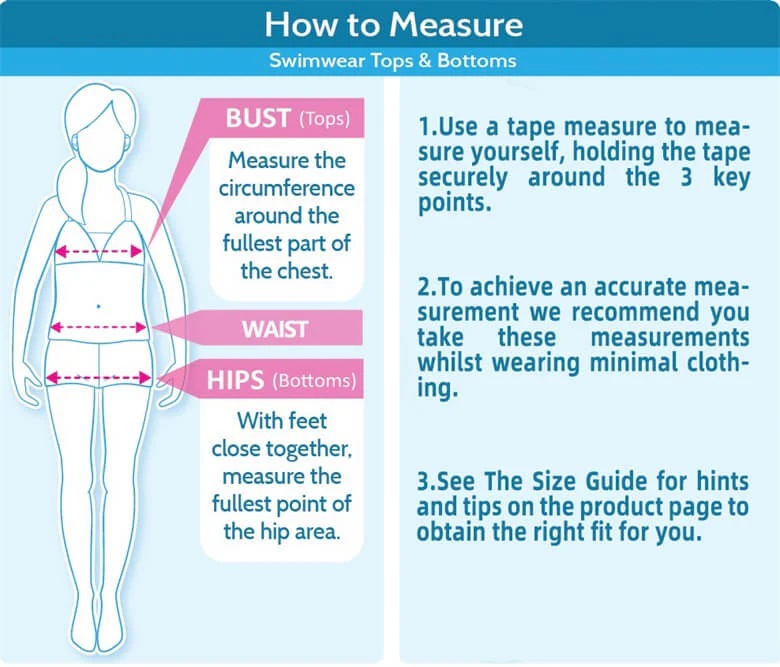
Tips for Accurate Measurements
To ensure you get the most accurate measurements possible, keep these tips in mind:
1. Use a flexible measuring tape: A soft, pliable measuring tape will conform to your body's curves better than a rigid ruler or yardstick.
2. Measure in the nude or with minimal clothing: Bulky clothing can add extra inches and skew your measurements.
3. Stand up straight: Good posture ensures that you're measuring your true dimensions.
4. Don't pull the tape too tight: The measuring tape should lie flat against your skin without digging in or creating bulges.
5. Measure twice: Take each measurement twice to confirm accuracy. If the numbers differ, take an average of the two.
6. Get help if needed: For hard-to-reach areas like your back or torso length, ask a friend or family member to assist you.
7. Be honest with yourself: Resist the temptation to "fudge" the numbers. Accurate measurements are key to finding a swimsuit that truly fits and flatters.
Understanding Swimsuit Size Charts
Once you have your measurements, it's time to consult size charts. Most swimwear brands provide size charts on their websites or product pages. These charts typically list sizes alongside corresponding body measurements.
It's important to note that sizing can vary significantly between brands. A size medium in one brand might be equivalent to a size large in another. Always refer to the specific brand's size chart rather than relying on your usual clothing size.
When looking at size charts, pay attention to the following:
1. Measurement units: Ensure you're looking at the correct units (inches or centimeters) that match your measurements.
2. Size ranges: Some charts may list a range of measurements for each size. If your measurements fall between sizes, consider sizing up for a more comfortable fit.
3. Fit descriptions: Some brands may describe their fit as "true to size," "runs small," or "runs large." Take these descriptions into account when making your selection.
4. International sizing: If you're shopping from an international brand, be aware that sizing conventions may differ. For example, European sizes are often different from US sizes.
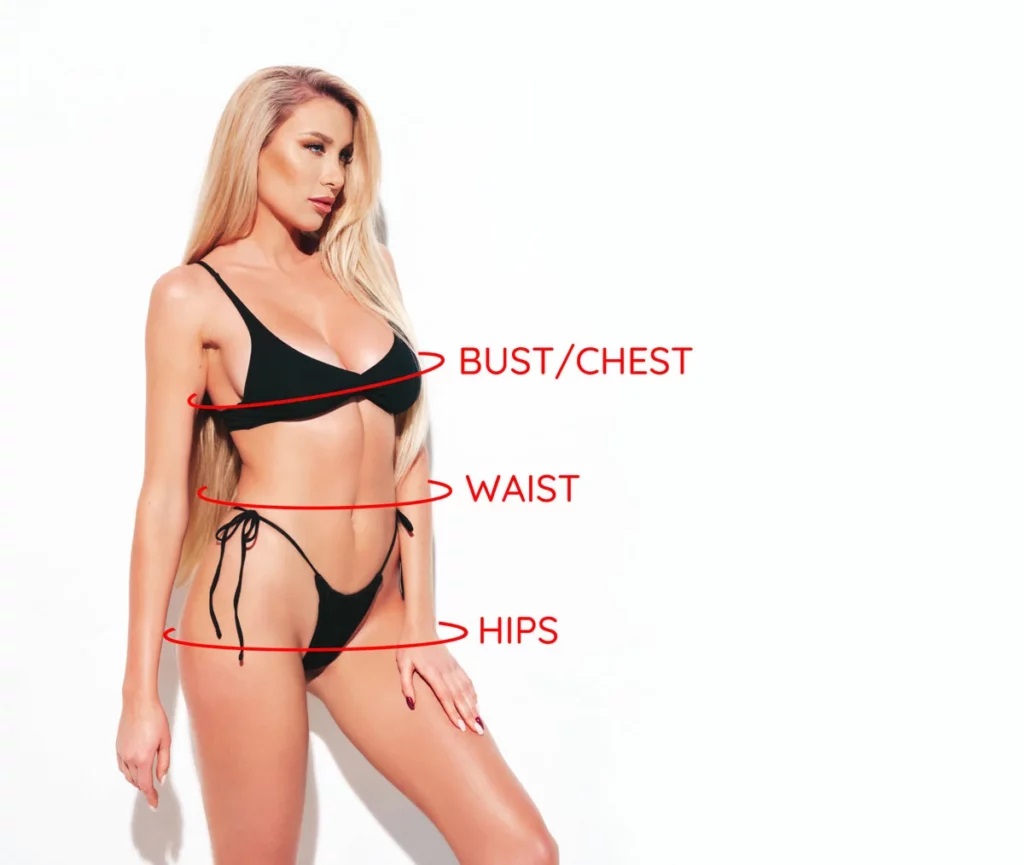
Choosing the Right Swimsuit Style for Your Body Type
While knowing your measurements is crucial, understanding which swimsuit styles complement your body type can also help you find the perfect fit. Here are some general guidelines:
1. Hourglass figure: If your bust and hips are roughly the same size with a defined waist, you can wear most styles. Bikinis and one-pieces that highlight your waist are particularly flattering.
2. Pear-shaped: For those with hips wider than their bust, look for swimsuits that balance your proportions. High-cut bottoms and tops with embellishments can create a balanced look.
3. Apple-shaped: If you carry weight around your midsection, consider swimsuits with ruching or tummy control panels. A-line tankinis or swim dresses can also be flattering.
4. Athletic build: To create curves, look for push-up tops, padded bikinis, or one-pieces with cut-out details.
5. Plus-size: Many brands now offer stylish plus-size options. Look for supportive underwire tops, high-waisted bottoms, or one-pieces with strategic draping.
Remember, these are just guidelines. The most important thing is to choose a swimsuit that makes you feel comfortable and confident.
Special Considerations for Different Swimsuit Types
Different types of swimsuits may require additional considerations when it comes to sizing:
1. Bikinis: When buying bikini separates, you may need different sizes for the top and bottom. This is perfectly normal and allows for a more customized fit.
2. One-piece suits: Pay special attention to torso length. A one-piece that's too short will pull uncomfortably, while one that's too long may sag.
3. Tankinis: These two-piece suits offer more coverage than bikinis. Ensure the top is long enough to meet the bottoms comfortably.
4. High-waisted bottoms: These can be particularly flattering but may fit differently than regular bikini bottoms. Pay attention to where they hit on your waist.
5. Bandeau tops: These strapless tops require a snug fit to stay in place. If you're between sizes, you might want to size down.
6. Swim shorts or board shorts: For these, you'll want to measure your waist and the circumference of your thighs for the best fit.
Online Shopping Tips for Swimwear
If you're shopping for swimwear online, here are some additional tips to help ensure you get the right fit:
1. Read customer reviews: Other shoppers often comment on whether a suit runs true to size, large, or small.
2. Check the return policy: Ensure the retailer has a good return or exchange policy in case the fit isn't quite right.
3. Look for detailed product descriptions: These often include information about the fabric, lining, and any special features like adjustable straps or removable padding.
4. Use virtual try-on tools: Some websites offer virtual fitting rooms where you can input your measurements to see how a suit might look on you.
5. Order multiple sizes: If you're unsure, order the size you think you need plus one size up and down. You can always return the ones that don't fit.
Caring for Your Swimsuit to Maintain Fit
Once you've found the perfect fitting swimsuit, proper care will help maintain its shape and fit:
1. Rinse after each use: This removes chlorine, salt, and sunscreen that can damage the fabric.
2. Hand wash with mild soap: Machine washing can be too harsh for delicate swimwear fabrics.
3. Avoid wringing or twisting: This can stretch out the fabric. Instead, gently squeeze out excess water.
4. Lay flat to dry: Hanging can cause the suit to stretch out of shape.
5. Rotate your suits: If you swim frequently, alternating between suits allows each one time to regain its shape between wears.
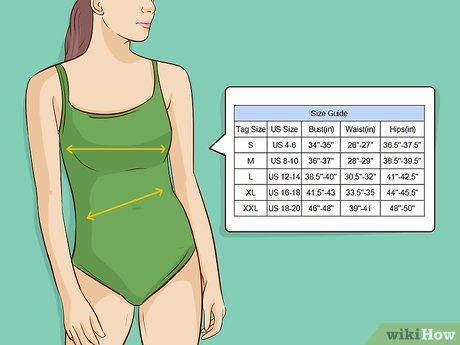
Conclusion
Finding the perfect fitting swimsuit doesn't have to be a daunting task. By taking accurate measurements, understanding size charts, and considering your body type and personal style preferences, you can find a swimsuit that not only fits well but makes you feel confident and comfortable.
Remember, the numbers on the tape measure or the size label don't define you. What matters most is how you feel in your swimwear. Choose a suit that allows you to move freely, supports you where you need it, and makes you excited to hit the beach or pool.
With this comprehensive guide, you're now equipped with the knowledge to measure yourself accurately and navigate the world of swimsuit sizing with confidence. So go ahead, find that perfect swimsuit, and make a splash this summer!






































